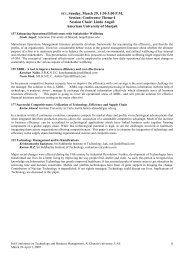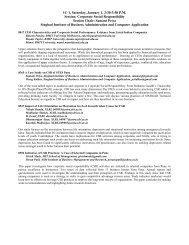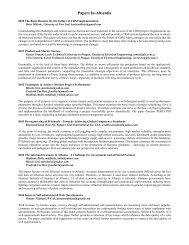Enormity of Emotional Labour and its Significance in the ... - Icmis.net
Enormity of Emotional Labour and its Significance in the ... - Icmis.net
Enormity of Emotional Labour and its Significance in the ... - Icmis.net
Create successful ePaper yourself
Turn your PDF publications into a flip-book with our unique Google optimized e-Paper software.
International Conference on Technology <strong>and</strong> Bus<strong>in</strong>ess Management March 18-20, 2013<br />
However, display rules have been conceptualized not only as role requirements <strong>of</strong> particular occupational<br />
groups, but also as <strong>in</strong>terpersonal job dem<strong>and</strong>s, which are shared by many k<strong>in</strong>ds <strong>of</strong> occupations<br />
6. <strong>Emotional</strong> labour <strong>and</strong> various occupations<br />
In The Managed Heart, Hoshchild shows how <strong>the</strong> flight attendant is tra<strong>in</strong>ed to manage fear at turbulence <strong>and</strong><br />
anger at cranky or abusive passengers, a bill collector is tra<strong>in</strong>ed to restrict compassion or lik<strong>in</strong>g for debtors. As<br />
<strong>the</strong> number <strong>of</strong> service jobs grows, so too does <strong>the</strong> amount <strong>of</strong> emotional labor.<br />
While many jobs can be stressful <strong>and</strong> even emotionally dra<strong>in</strong><strong>in</strong>g at times, it is <strong>in</strong> personal service occupations<br />
that emotional labour becomes a rout<strong>in</strong>e dem<strong>and</strong> made on workers <strong>in</strong> <strong>the</strong> normal course <strong>of</strong> <strong>the</strong>ir day. Among<br />
o<strong>the</strong>r samples, such as sales representatives <strong>and</strong> debt collectors, Hochschild's research gave most attention to<br />
airl<strong>in</strong>e flight attendants employed by a private carrier with a reputation for high quality service while seen by<br />
many as an <strong>in</strong>terest<strong>in</strong>g <strong>and</strong> even glamorous career; it also qualifies as one which can make heavy dem<strong>and</strong>s <strong>in</strong><br />
terms <strong>of</strong> emotional labour. The flight attendant, for example, must make passengers feel safe <strong>and</strong> well cared for<br />
<strong>in</strong> a pleasant environment, almost like guests <strong>in</strong> his or her own home. At <strong>the</strong> same time, <strong>the</strong>y must repress <strong>the</strong>ir<br />
own feel<strong>in</strong>gs <strong>of</strong> anger or fear <strong>in</strong>duced by difficult passengers or dangerous <strong>in</strong>-flight <strong>in</strong>cidents. Unlike workers <strong>in</strong><br />
o<strong>the</strong>r jobs, <strong>the</strong> flight attendant is expected to be as friendly, composed <strong>and</strong> alert at <strong>the</strong> end <strong>of</strong> a 16-hour shift as<br />
at <strong>the</strong> beg<strong>in</strong>n<strong>in</strong>g. They are required to present a positive image <strong>of</strong> <strong>the</strong> airl<strong>in</strong>e, <strong>and</strong> even <strong>its</strong> home country, to large<br />
groups <strong>of</strong> people <strong>in</strong> a conf<strong>in</strong>ed space who are able to observe any sign <strong>of</strong> annoyance or <strong>in</strong>s<strong>in</strong>cerity.<br />
In <strong>the</strong> early organizational literature on emotional labor <strong>in</strong> service sett<strong>in</strong>gs, <strong>the</strong> work <strong>of</strong> Rafaeli <strong>and</strong> Sutton was<br />
prom<strong>in</strong>ent <strong>and</strong> <strong>the</strong>y focused on emotional labor <strong>in</strong> service sett<strong>in</strong>gs, across a variety <strong>of</strong> service jobs, <strong>and</strong> showed<br />
that customer reactions <strong>and</strong> organizational outcomes, particularly sales, were <strong>in</strong>deed affected by how employees<br />
express <strong>the</strong>ir feel<strong>in</strong>gs. Positive attitudes expressed by employees can create favorable impressions <strong>in</strong> customers’<br />
m<strong>in</strong>ds, <strong>and</strong> negative attitudes can similarly engender unfavorable impressions (Pugh, 2001; Schneider,<br />
Park<strong>in</strong>gton, & Buxton, 1980). When employees are seen by customers to be rude, or <strong>the</strong>y behave<br />
<strong>in</strong>appropriately towards customers, an organization may lose <strong>in</strong> many ways. Not only may a direct sale be lost,<br />
but also future revenue from both <strong>the</strong> <strong>of</strong>fended customer as well as everyone he/she conv<strong>in</strong>ces to avoid<br />
patronage. Fur<strong>the</strong>r, while we know that positive outcomes are <strong>of</strong>ten associated with positive expression <strong>of</strong><br />
emotion by employees (Pugh, 2001), <strong>the</strong> full effects <strong>of</strong> positive <strong>and</strong> genu<strong>in</strong>e emotional expression by employees<br />
can have far-rang<strong>in</strong>g beneficial effects for <strong>the</strong>ir employer.<br />
Pugh (2001) found that displays <strong>of</strong> positive emotions by bank employees were related to displays <strong>of</strong> positive<br />
affect by customers, <strong>and</strong> that <strong>the</strong>se displays impacted positively on <strong>the</strong>ir evaluations <strong>of</strong> overall service quality.<br />
Teach<strong>in</strong>g is a pr<strong>of</strong>ession that <strong>in</strong>volves a high level <strong>of</strong> emotional labour. This <strong>in</strong>cludes such behaviours as<br />
surface act<strong>in</strong>g (display<strong>in</strong>g an emotion that is not actually felt), deep act<strong>in</strong>g (<strong>the</strong> activity undertaken to actually<br />
feel a required emotion), <strong>and</strong> suppression <strong>of</strong> emotion .Teachers are expected to perform emotional labour <strong>in</strong><br />
order to achieve <strong>the</strong> dual outcomes <strong>of</strong> customer (i.e., student satisfaction, <strong>and</strong> pr<strong>of</strong>it for <strong>the</strong> management)Studies<br />
revealed that manag<strong>in</strong>g <strong>the</strong> emotional dem<strong>and</strong>s <strong>of</strong> teach<strong>in</strong>g requires considerable effort. Teachers who perform<br />
more emotional labour tend to be more emotionally exhausted <strong>and</strong> less satisfied with <strong>the</strong>ir teach<strong>in</strong>g career - <strong>the</strong>y<br />
also experience more conflict between <strong>the</strong>ir work <strong>and</strong> home lives. The emotional dem<strong>and</strong>s <strong>of</strong> teach<strong>in</strong>g also<br />
attracts wide research <strong>and</strong> it is been found that it can even threaten teachers’ health, job satisfaction, work-life<br />
balance wellbe<strong>in</strong>g <strong>and</strong> relationships with pupils.<br />
Increas<strong>in</strong>gly, <strong>the</strong> role <strong>of</strong> <strong>the</strong> Information Technology department with<strong>in</strong> organisations is seen as a service role.<br />
At <strong>the</strong> heart <strong>of</strong> IT services is <strong>the</strong> service encounter, <strong>the</strong> po<strong>in</strong>t where <strong>the</strong> customer <strong>and</strong> <strong>the</strong> IT service employee<br />
<strong>in</strong>teract, whe<strong>the</strong>r over a phone at <strong>the</strong> help desk, <strong>in</strong> <strong>the</strong> <strong>of</strong>fice at <strong>the</strong> desktop, or <strong>in</strong> a corridor. This service role for<br />
<strong>in</strong>formation technology moves <strong>the</strong> focus to customers s<strong>in</strong>ce deliver<strong>in</strong>g a service is about meet<strong>in</strong>g customers’<br />
needs. The thous<strong>and</strong>s <strong>of</strong> <strong>in</strong>dividual service encounters make up <strong>the</strong> service <strong>and</strong> determ<strong>in</strong>e <strong>the</strong> quality <strong>of</strong> <strong>the</strong><br />
service as perceived by customers. The rapid rise <strong>of</strong> <strong>the</strong> service sector, particularly <strong>the</strong> call centre <strong>in</strong>dustry has<br />
made <strong>the</strong> study <strong>of</strong> emotional labour <strong>in</strong>creas<strong>in</strong>gly important. The In a lot <strong>of</strong> IT <strong>in</strong>dustry, for example <strong>in</strong> call<br />
centres, most <strong>of</strong> <strong>the</strong> service <strong>in</strong>teractions are voice to voice between two <strong>in</strong>dividuals. Regular compla<strong>in</strong>ts <strong>and</strong> <strong>the</strong><br />
anger <strong>of</strong> frustrated members <strong>of</strong> <strong>the</strong> public can leave call centre staff emotionally dra<strong>in</strong>ed <strong>and</strong> less able to respond<br />
appropriately to customer calls. call h<strong>and</strong>lers voice is analysed for pace, volume <strong>and</strong> timbre to ensure <strong>the</strong> right<br />
`mood'. <strong>Emotional</strong> labour is particularly required <strong>in</strong> jobs <strong>in</strong> call centres where irate or rude customers are<br />
frequently encountered.. High levels <strong>of</strong> turnover <strong>and</strong> absenteeism <strong>in</strong> <strong>the</strong> <strong>in</strong>dustry <strong>in</strong>vites special attention<br />
because <strong>of</strong> <strong>the</strong> relationship between <strong>the</strong> emotional dem<strong>and</strong>s (emotional labour) <strong>of</strong> call centre work <strong>and</strong> job<br />
satisfaction<br />
Nurs<strong>in</strong>g <strong>and</strong> health care is one big m<strong>in</strong>efield <strong>in</strong> <strong>the</strong> emotional labour stakes. For a nurse who sees herself as<br />
a car<strong>in</strong>g ,compassionate person, tak<strong>in</strong>g a few moments to console a patient <strong>in</strong> distress represents not a burden<br />
but makes her job more mean<strong>in</strong>gful. Inorder to show compassion, care <strong>and</strong> warmth , nurses have to suppress<br />
167







